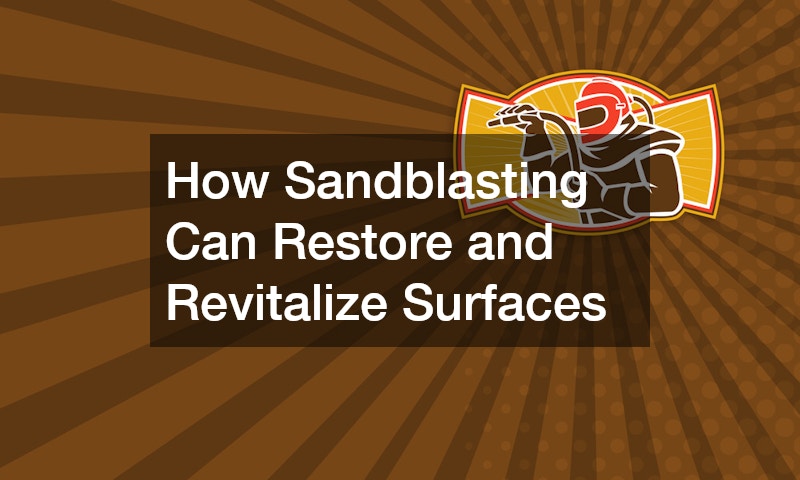Understand the transformative power of sandblasting for restoring and revitalizing surfaces. Learn how this technique can restore life to old, rusted, or weathered surfaces, making them look new and enhancing their longevity. With the right technique and equipment, surfaces can be renewed, improving both their aesthetic appeal and functional performance.
What is Sandblasting and How Does It Work?
Understanding the Basics of Sandblasting
Explore what sandblasting entails, including the types of abrasives used and how the process works to clean and smooth surfaces. At its core, sandblasting involves using high-pressure air to propel fine materials, such as sand, glass beads, or steel grit, against a surface. This powerful action removes dirt, rust, paint, and other unwanted layers, leaving behind a clean and smooth surface.
Sandblasting is exceptionally versatile and applicable to a wide range of surfaces including metal, concrete, wood, and plastic. This adaptability makes it a favored technique in industries such as automotive restoration, construction, and manufacturing. It offers a quick and efficient way to prepare surfaces for further treatment, such as painting or sealing.
The Equipment and Tools Used in Sandblasting
Gain insight into the various types of sandblasting equipment and tools, such as air compressors, blast booths, and media used. Air compressors play a pivotal role, providing the necessary pressure to propel the blasting media effectively. The type of blast cabinet or booth used can significantly impact the efficiency and accuracy of the sandblasting process.
Additionally, the choice of media is critical in determining the outcome of the blasting process. Each blasting situation may require different media types, with variations in hardness, size, and composition guiding their selection. It’s essential to match the media type with the specific needs of a project to achieve optimal results.
Safety Precautions and Measures
Learn vital safety practices and protective measures essential for safe sandblasting, including personal protective equipment and workspace controls. Sandblasting involves significant risks, such as exposure to dust and flying debris, which necessitate stringent safety protocols. Protective gear, including respirators, gloves, and goggles, is non-negotiable to safeguard operators’ health.
Environmental controls like ventilation systems and dust collectors are crucial in maintaining a safe workspace. These systems help mitigate the exposure to hazardous particles, reducing health risks for workers. Compliance with industry safety standards and guidelines is equally important in promoting safe sandblasting practices.
Training and awareness about sandblasting safety convert potential hazards into manageable risks. Comprehensive training ensures workers understand the associated dangers and the necessary precautions to avoid accidents. Encouraging a culture of safety within sandblasting operations promotes efficiency and worker well-being.
Benefits of Sandblasting in Surface Preparation
Enhanced Surface Adhesion
Discover how sandblasting enhances adhesion for subsequent surface treatments such as painting, coating, or sealing. The process ensures a smooth, clean surface free from residues that could otherwise compromise adhesion. This results in longer-lasting finishes and reduced maintenance needs over time.
A well-prepared surface adheres better to paints and coatings, resulting in superior finish and durability. This is particularly important in industrial applications where longevity and surface integrity are critical. When surfaces are uniformly prepared, the risk of coating failure is significantly minimized, preserving the investment over time.
Removing Rust and Contaminants
Understand the effectiveness of sandblasting in removing rust, paint, and various contaminants, leading to a clean, polished surface. Rust removal is a key application of sandblasting, particularly for metal surfaces that have suffered corrosion. The abrasive impact of sandblasting dislodges rust layers, rejuvenating the underlying material.
Likewise, sandblasting effectively strips old paint, preparing surfaces for new finishes. This method ensures a clean canvas free from old coatings and residues that could affect the new paint’s adherence. It allows consistent application of fresh paint, contributing to a high-quality, professional appearance.
Versatility and Application
Explore the versatility of sandblasting, including its application across various industries and on diverse surface materials. Sandblasting’s adaptability enables it to be used on various materials, from metals to woods, concretes, and even certain plastics. This versatility makes it indispensable in wide-ranging fields, including automotive, aerospace, construction, and art restoration.
The adaptability of sandblasting extends to the variety of techniques and equipment that cater to different project needs. From small, portable sandblasters for detailed work to massive industrial systems for large-scale projects, options abound. This flexible applicability to diverse tasks highlights sandblasting as a go-to solution for surface restoration challenges across many sectors. From enhancing surface adhesion to removing rust and contaminants, sandblasting proves to be an invaluable tool. Its versatility and efficiency position it as a preferred method for achieving long-lasting, aesthetically pleasing surfaces in various industries.
.



